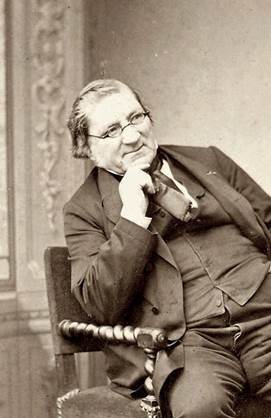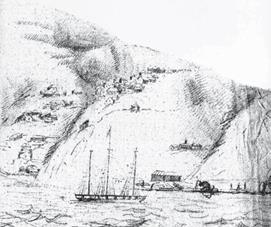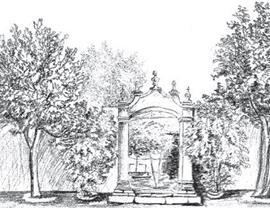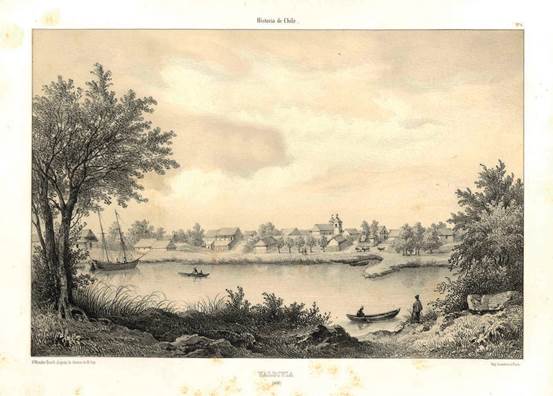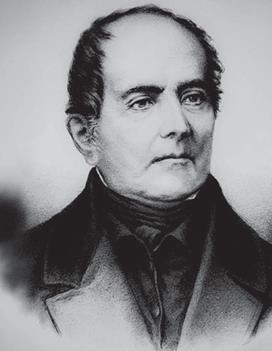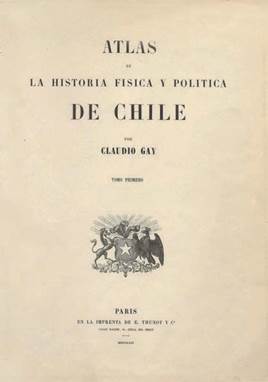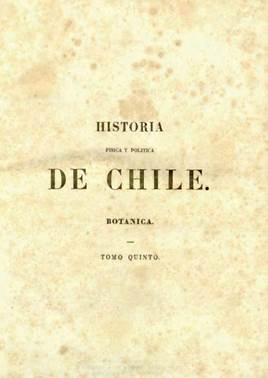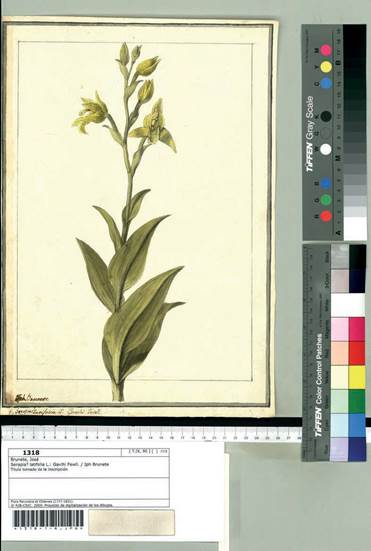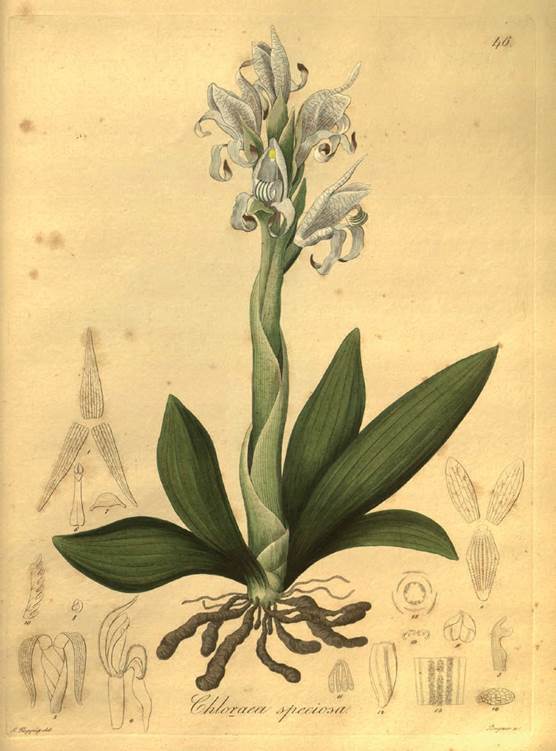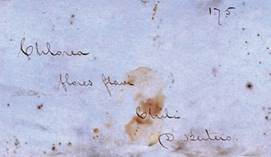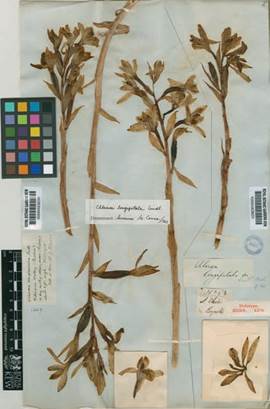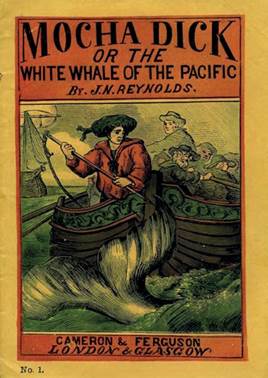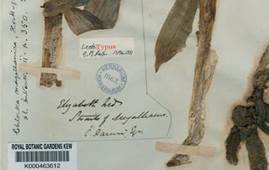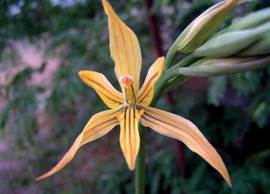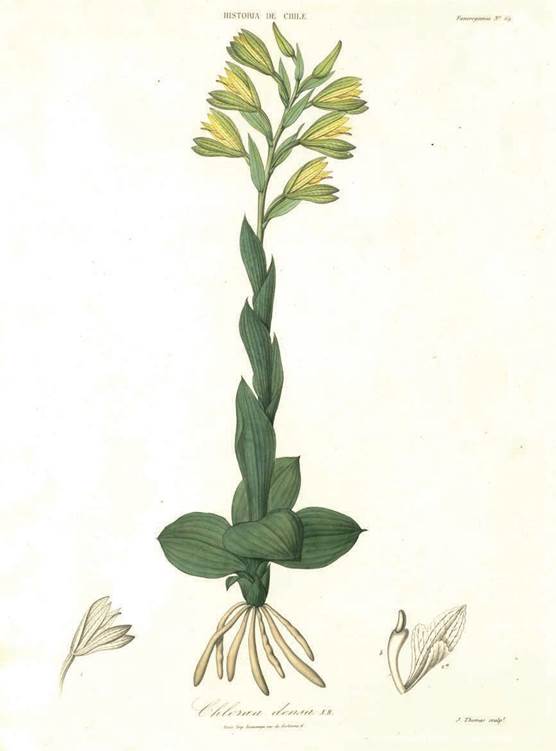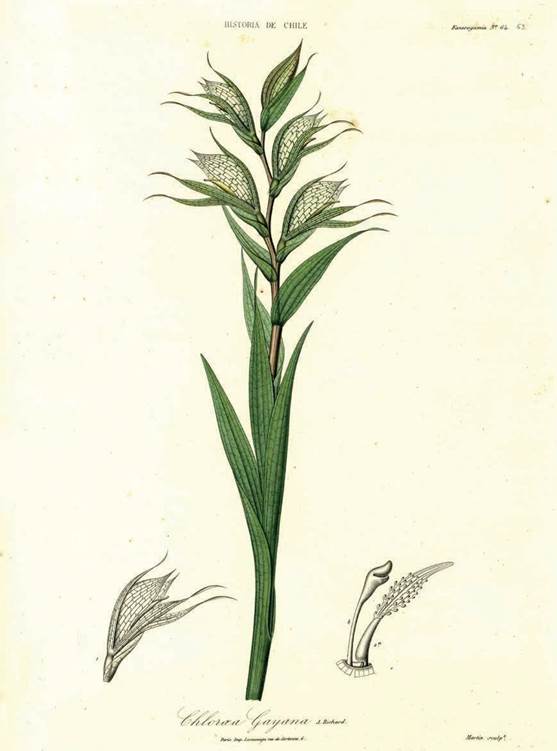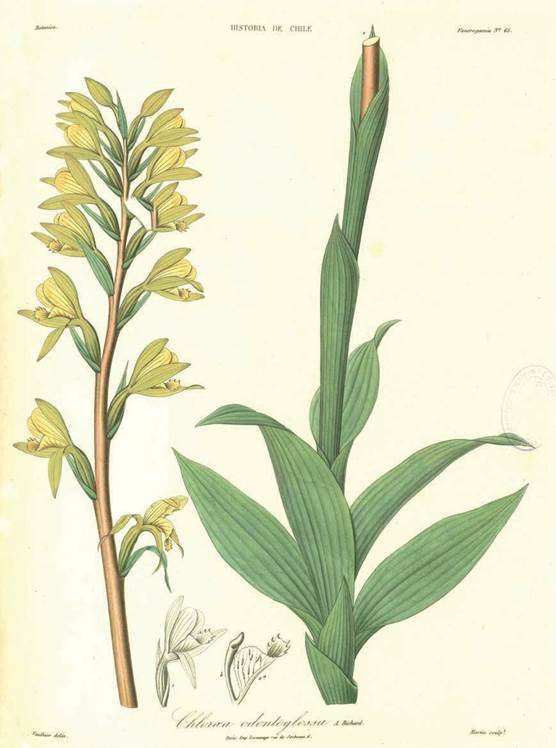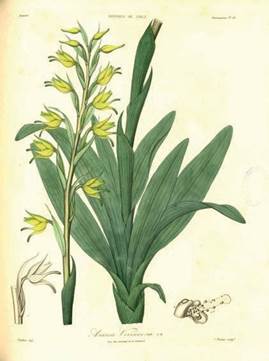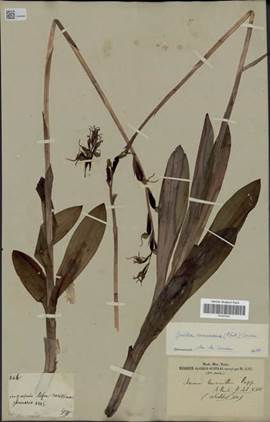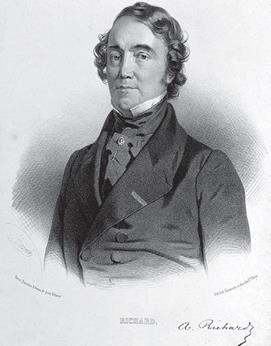Introduction
The Southern Cone is a geographic and cultural region comprising the republics of Argentina, Chile, and Uruguay, and in its broadest definition, also Paraguay and the southernmost states of Brazil. Bordered on the west by the Pacific and on the east by the Atlantic Ocean, the territory is located mostly south of the Tropic of Capricorn.
The southern cone of South America, with its tip pointed towards Antarctica, is a region of over 1.5 million square miles (more than 4 million square kilometers) that includes territory in the republics of Chile, Argentina, and Uruguay. The Tropic of Capricorn crosses it in the north. By virtue of its position, it contains highlands and lowlands of middle latitudes, with a marked influence of the Atlantic Ocean and a succession of tropical to cold climates in the extreme south. In the west rises the imposing Andean mountain range and associated mountain ranges. The cold waters of the Pacific bathe the coasts of Chile, forming deserts. The climatic and regional diversity provided abundant resources and various scenarios for the development of complex biodiversity.
Towards the east, the 'pampas' or grasslands of the Southern Cone consist of temperate prairies and savannas shared by Argentina and Uruguay. To the north of Argentina and bordering Uruguay and Bolivia, the Chaco region is a system of plains and dry forests crossed by important river systems. To the south, Patagonia extends from the Colorado River to Tierra del Fuego, which Argentina shares with Chile. South America's Arid Diagonal, a zone of arid and semi-arid climate, crosses from the desert of Atacama in northern Chile across the Andes to the Atlantic coast of Patagonia (Fig. 1).
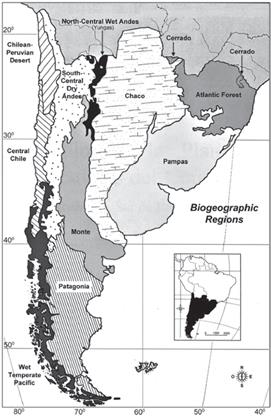
In Zuloaga & Belgrano, 2015: Fig. 2
Figure 1 Biogeographic regions of the Southern Cone of South America.
In Chile, the central region south of Atacama has a Mediterranean climate, and the desert gives way to fertile valleys that reach as far as the Region of the Lakes in the south with its capital Puerto Montt. Chilean Patagonia is very similar to its Argentinian counterpart, and both countries come together at Tierra del Fuego, on the shores of the Strait of Magellan.
Concerning the Orchidaceae and according to Zuloaga and Belgrano (2015), the orchid family is represented in the Southern Cone by 158 genera and 1042 species, of which 294 are endemics.
Claude Gay (1800-1873) (Fig. 2) was born in March 1800 in Draguignan, in the French region of Provence. He finished his elementary and secondary studies in his hometown and, in 1818, traveled to Paris to study medicine and pharmacy. Instead, he became interested in Natural Sciences and began attending public courses at La Sorbonne and the Natural History Museum. Between 1821 and 1828, he studied Botany and Entomology and later taught himself Physics, Chemistry, Geology, and Comparative Anatomy (Díaz Céspedes 2017). He kept fond memories from his time at the Natural History Museum. As he wrote in his travel journal: ''The abundant collections of objects of natural science, the high scientific level of the courses taught there, the interest of the professors in helping me with my studies, all contributed powerfully to making me love a science that I had already taken up on my own and studied with my own effort'' (Gay 2008).
Having turned his attention to traveling overseas, Gay mentions in his travel journal failed efforts to travel to America until he was told that ''a society of persons was being organized in Paris to found a university in Santiago de Chile under the special protection of the French and the Chilean governments (…) The pleasure joined to the interest of discovering a country unknown to naturalists led me without hesitation to accept the proposal of appointing me professor of Chemistry and Physics'' (Gay 2008, cited in Sagredo Baeza 2012). Inspirer of this 'society of persons' was Chilean journalist Pedro Chapuis, on a mission for the Chilean government, with whom Gay signed in 1828 a preliminary agreement to form, initially, a group of teachers dedicated to the study of natural sciences in an educational establishment in the capital of the country (Díaz Céspedes 2017). Chapuis completed his mission by integrating other French intellectuals into the group, among them Juan Antonio Portes (Philosophy), José Coupelon (Medicine), Teodoro Moriniére Roman (Law) e Hipólito Beauchemin (French).
To fully understand the presence of Claude Gay in Chile, it is necessary not only to relate it to the French interest in exploring southern South America but also to the urgencies and necessities of the nascent Chilean state. The country's leaders, even before the country's final independence from Spain in 1826, when the last Spanish troops surrendered and the island of Chiloé was incorporated into the Chilean Republic (only three years before Gay's arrival in Chile), had insisted on the urgency of creating educational institutions and the need to promote the geographic survey and recognition of the territory.
The Chilean government sponsored Gay's work amidst the national euphoria that arose from Chile's victory in the war against the Peru-Bolivian Confederation in (1836-1839). The government, stimulated by popular enthusiasm and patriotic fervor, embraced the benefits of promoting Chile's educational system, attempting to reflect the stature of a republic that had recovered its glory on the battlefield (Sagredo Baeza 2015).
Claude Gay arrived in Valparaíso at the end of 1828 and a few weeks later began to work at the shortlived Colegio de Santiago as an ordinary professor of Physics and Natural History (Fig. 3-4). But it was in 1830 that his career in Chile took a transcendental turn when he signed a new contract, this time with the government of Chile represented by Minister Diego Portales, to organize a surveying expedition across Chile and to study and collect specimens of flora and fauna.
The collected specimens should form the base for a Cabinet of Natural History. It was the starting point for Gay's two major contributions: the foundation of the National Museum of National History in Santiago (1830) and the future publication of his Physical and Political History of Chile (1844-1871) (Díaz Céspedes, 2017: 2). Gay would receive a monthly salary of one hundred and twenty-five pesos during the next four years; the necessary instruments for his geographical observations; a prize of three thousand pesos at the end if he fulfilled the objectives of the expedition, and the promise to send instructions to all majors and governors of villages and provinces with orders to provide him with assistance and information about their respective territories (Muñoz Schick 2010).
Gay's first expedition took him in December 1830 to the region of Atacama and the province of Colchagua, where he explored the coastal region, the Andes mountain chain, the rivers Cachapoal and Cipreses, and the volcano of Tinguiririca.
In March 1832, Gay embarked in Valparaíso with France as his destination, with instructions to purchase the instruments and books necessary for his work. He also had with him plants and seeds he donated to the National History Museum in Paris. He was received with enthusiasm and, before returning to Chile, was decorated with the Cross of the French Legion of Honor.
Back in Chile, he continued his explorations of the territory, visiting the southern regions of Osorno and Valdivia in 1834, the island of Chiloé in 1835, and crisscrossing the central provinces of Concepción, Coquimbó, San Fernando, Vichuquén, Pencahue, Constitución, and Chanco, until completing in 1841 his explorations of all Chilean provinces, including an interlude in Peru from 1839 to 1840, where he studied historical documents kept in Lima. During these expeditions, Gay prepared several sketches illustrating landscapes, urban scenes, and scenes of daily life in rural Chile, which would be the base for his Atlas de la Historia Física y Política de Chile (volume I) published in 1854 (Fig. 5 - - - 9).
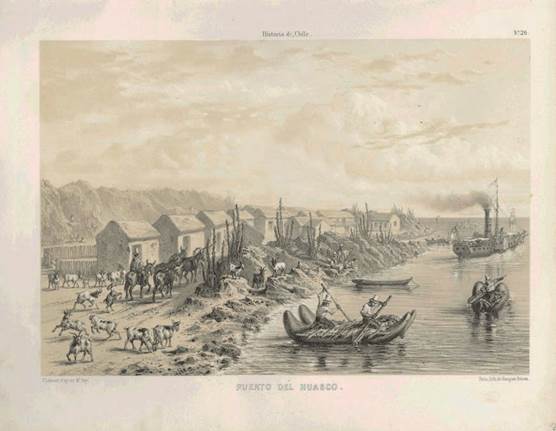
By Claude Gay. Atlas de la Historia Física y Política de Chile, vol. I: plate 64.
Figure 5 Harbor of El Huasco, province of Atacama.
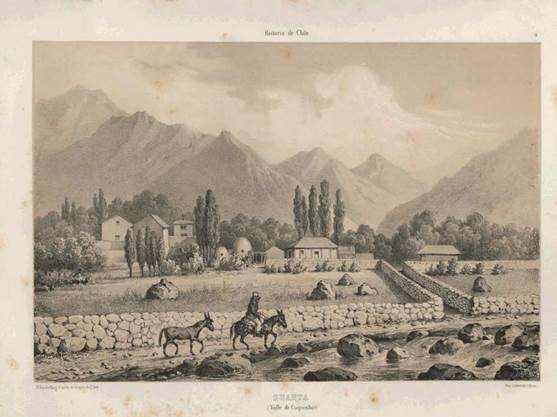
By Claude Gay. Atlas de la Historia Física y Política de Chile, vol. I: plate 5.
Figure 6 Guanta, province of Coquimbo.
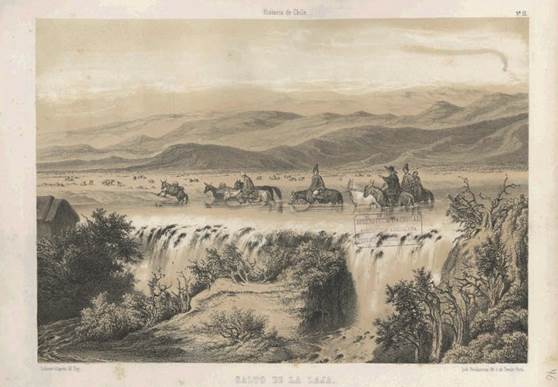
By Claude Gay. Atlas de la Historia Física y Política de Chile, vol. I: plate 13.
Figure 8 Waterfalls of La Laja, province of Biobio.
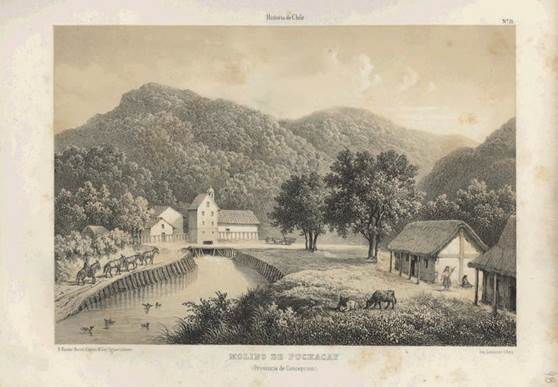
By Claude Gay. Atlas de la Historia Física y Política de Chile, vol.I: plate 15.
Figure 9 Mill of Puchacán, province of Concepción.
Claude Gay's Historia Física y Política de Chile
''The zeal and passion that Gay showed for natural history, manifested in his indefatigable activity and devotion to study, not only drew the attention of the few individuals interested in the Natural Sciences living in Santiago. They also reached the ears of the authorities, who had been considering the idea of making a scientific study of the country, a long-held aspiration, which they had not been able to materialize for lack of a competent individual to undertake it'' (Sagredo Baeza 2012). Claude Gay's work in Chile was strongly supported by two main players in Chile's early republican life. Diego Portales (1793-1837) (Fig. 10), Minister of the Interior and probably Chile's most influential politician of the 19th century had sent Pedro Chapuis to France on the mission that finally resulted in Gay's arrival in Chile.
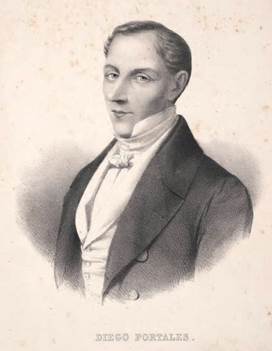
Atlas de la Historia Física y Política de Chile, vol. I (1854).
Figure 10 Diego Portales (1773-1837).
Portales continuously promoted Gay's work but found a premature death in 1837 during a military uprising in the course of Chile's war against the Peru-Bolivian Confederation. He would never see the results of Gay's work. On the other hand, Gay enjoyed the friendship and support of Andrés Bello (1771-1865) (Fig. 11), a Venezuelan-Chilean humanist, who in his younger years had been one of Simón Bolivar's teachers and has been regarded as the father of Chile's educational system. Bello strongly supported Claude Gay, and under his inspiration, the University of Chile was created in 1842. Bello became its first rector, a post he held for over two decades.
Claude Gay published in the newspaper El Araucano (then under the direction of Andrés Bello) on January 29, 1841, his Prospecto de la Historia Física y Política de Chile. It was the official presentation of what would become Gay's monumental project on Chile's natural and political history. There, together with summarizing his scientific work sponsored by the government, he argued in favor of ''the proposed edition, for its usefulness as well as for the urgency of disseminating the result of his own scientific efforts for the advantage of the inhabitants of the country''. This country, Gay continued, ''not long ago still looked upon as a province of Peru, plays today a major role and offers to the New World an example of progress and prosperity'' (Sagredo & Donoso 2012).
After spending eleven years traveling throughout Chile, Claude Gay returned to Paris and between 1844 and 1871 published his monumental work, Historia Física y Política de Chile, in 30 volumes comprising Botany, Zoology, Agriculture, History, and Geography, with prints and maps of Chile as it was then. The work was complemented with three volumes of the Atlas illustrating Chile's geography (landscapes, urban and rural scenes), botanical, and zoological species (Fig. 12-13).
The monumental Historia Física y Política de Chile of Claude Gay not only summarized the existing knowledge about the country in the first half of the 19th century but became the base for the future work of other outstanding scientists such as Ignacio Domeyco and Rodulfo Philippi, who continued in Gay's footsteps (Sagredo & Donoso 2012).
For our purposes, we will concentrate on Botany, volume V (Orchidaceae in pp. 435-478), published in 1849, and on volume I of the Atlas (illustrations of Geography and Flora, including Orchidaceae in plates Fanerogamia 64, 64a, 65, 66), published in 1854.
The orchids in Gay's Historia Física y Política de Chile
Chile's orchids had been only insufficiently collected and studied during the 17th and the first decades of the 18th centuries, before Claude Gay's arrival. John Lindley introduced Chile's orchids in his Remarks upon the Orchideous plants of Chile: ''Much as has been done in investigating the vegetable productions of South America, it must be confessed that we still are far from possessing any very definite notions of the botany of that vast continent. But if this is true of the South American Flora in general, it is much more so with concerning the southern provinces, and especially with regards to Chile. The number of plants recorded in scientific works, as natives of that region, are so few compared with what may be presumed to contain from analogy, that its botany may be considered almost entirely unknown. It is true, indeed, that a very considerable addition to the published lists of Chilian plants might be made from the examination of certain private herbaria; but as far as the scientific world, in general, is concerned, the statement above made is strictly accurate (…) In this country, which, in the eyes of botanical geographers, forms a vegetative region in itself -which extends through twenty degrees of southern latitude, and which has a surface varied with all the irregularity of mountains covered with eternal snow, rich valleys, and extensive plains, no more than three species of Orchideae are at this moment recorded to exist, and these are known only by the figures and imperfect descriptions of Feuillée.'' (Lindley 1827).
A retrospective view of the Chilean orchidology of the 18th and early 19th centuries will prove how right Lindley was with his previous remarks.
Louis Éconché Feuillée (1660-1732), a French botanist and monk, described and prepared herbarium specimens of the first known four Chilean orchids, which he presented to the public between 1714 and 1725 under the title Journal des observations physiques, mathematiques et botaniques, faites par l'ordre du Roy sur les Côtes Orientales de l'Amerique Meridionale, & dans les Indes Occidentales, depuis l'année 1707 jusques en 1712, volumes 1-3 (Feuillés 1714a,b, 1725). Feuillée's orchids, described by him in pre-Linnean nomenclature, were Epipactis floribus uno verso dispositis vulgo Nuil (= Brachystele unilateralis (Poir.) Schltr.), Epipactis flore albo, vulgo Gavilú (= Gavilea venosa (Lam.) Garay & Ormerod), Epipactis flore virescente et variegato vulgo Piquichen (= Chloraea virescens (Willd.) Lindl.) (the type species for the genus Chloraea) (Fig. 14), and Epipactis amplo flore luteo, vulgo Gavilú (= Chloraea gavilú Lindl.) (Ossenbach 2020).
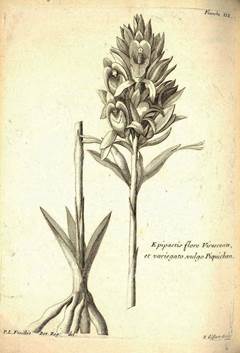
Figure 14 Epipactis flore virescente etc. variegato vulgo Pichiquen (= Chloraea virescens (Willd.) Lindl.) by Feuillé, Vol. II: pl. XIX (1714b).
In 1767-1768, Philibert Commerson (1727- 1773), who sailed as a botanist with the expedition of Louis Antoine de Bougainville, collected Chloraea commersonii Brong. on the Chilean shores of the Strait of Magellan.
Hipólito Ruiz (1754-1816) and José Antonio Pavón (1754-1809) led the Royal Spanish Expedition to Perú and Chile (1777-1815) and, in 1782, sailed from Lima to Valparaíso, collecting plants in Chile in 1782 and 1783. Their efforts produced only one collection of a Chilean orchid illustrated by José Brunete. It is a species of Chloraea (Fig. 15). The illustration is annotated: Serapias latifolia? gavilú Feuill. and the plant was described in 1840 by Lindley as Chloraea pavonii with the indication ''Hab. in Chili. Pavón'' (Lindley 1840). However, Garay and Romero-González (1998) questioned this and pointed to a Peruvian origin of this plant. Lindley found the herbarium specimen on which he based his description in Aylmer Bourke Lambert's herbarium. Lambert had bought it, amongst hundreds of others, from José Antonio Pavón, in charge during those years of the Oficina botánica in Madrid.
Juan Ignacio Molina (1740-1829) published in 1782 his Saggio sulla storia naturale del Chili, another attempt to produce a Natural History of Chile. He did not mention any orchids and is, therefore, of no further interest to our story.
Alessandro Malaspina (1754-1810) departed from the Spanish port of Cádiz in 1789 in command of the Spanish expedition to the Pacific (1789-1794), which took him to South, Central, and North America, and further to the Philippine Islands, before returning to South America on their homeward journey to Spain. Onboard Malaspina's corvettes were French botanist Louis Née (1734-1807) and the Czech Thaddeus Haenke (1761-1816). In 1790 the expedition disembarked in Valparaíso. Louis Née collected only one species of Orchidaceae on this occasion, an undetermined species of Spiranthes. As to Haenke, Malaspina would later comment that he collected over 1400 plants, many of them new to science (Malaspina 1938). On their return journey, the expedition arrived in Lima, where Haenke decided to leave the expedition. He would stay in South America for the rest of his life. During the first months, he traveled to Chile to recover from the hardships of the journey (Ramos & Alonso, 2018). The collection date is unknown, but on one of his two visits to Chile, Haenke collected an orchid specimen that C.Presl described later as Cymbidium ramosissimum, a plant that has so far remained undetermined (Presl 1830).
Hugh Cuming (1791-1865), the ''Prince of Collectors'', arrived in Chile in 1810. Born in the village of Washbrook, Devon, Cuming met the naturalist Colonel George Montagu, who lived nearby and is said to have inspired his interest in natural history. Cuming had not received a lengthy formal education and was apprenticed to a sailmaker at the age of thirteen. With this trade in mind and inspired by many of the seafarers he met during his work, he emigrated to South America, settling in Valparaiso in 1819. Within a few years, by 1826, having accumulated some wealth, he decided to retire from business to devote the rest of his days to collecting shells and other specimens of natural history. He built himself a schooner, the Discoverer, specifically for collecting trips and made his first major journey aboard her in 1827 to Tahiti, via the Juan Fernandez Islands, Easter Islands, and Pitcairn, seeking shells and plants. On the second journey in 1828, which is the one of interest for our purposes, he sailed along the west coast of South America, reaching as far north as the edge of El Salvador and as far south as Chiloe Island, stopping off in numerous locations to make collections (Ossenbach 2020). In 1834, John Lindley published a Catalogue of the Orchideae in Mr. Cuming's collection of South American plants, in which several new Chilean orchid species were described, among them Asarca aurantiaca Lindl. (= Chloraea chrysantha Poepp.), Bipinnula mystacina Lindl. (= Bipinnula fimbriata (Phil.) I.M.Johnst.), Chloraea affinis Lindl. (= Chloraea bletioides Lindl.), Chloraea barbata Lindl. (Fig. 16), Chloraea cristata Lindl., and Chlorea volucris Lindl. (= Gavilea glandulifera (Poepp.) M.N.Correa).
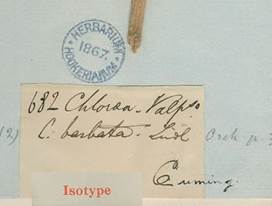
Figure 16 Cuming's herbarium label of Chloraea barbata Lindl. Royal Botanic Gardens, Kew, Herbarium Hookerianum (N° 682, Valparaíso).
In 1824, the Hawaiian Royal couple, King Kamehameha and Queen Kamamalu arrived in London on an official visit. King Kamehameha intented to sign an agreement with the British government seeking protection for the Hawaiian kingdom from external forces. Tragically, the King and Queen came down with measles in late June 1824 and died a few weeks later. In September 1824, their coffins were placed on board HMS Blonde, and under the command of Captain George Anson began their journey to their final resting place in Hawaii. The Horticultural Society of London obtained permission to send a fine collection of plants to Hawaii, considered suitable for the climate of the islands, under the charge of James Macrae (1800-1830), a young Scot trained as a plant collector and horticulturist. On their return journey, the Blonde spent the final months of 1825 in the Chilean ports of Valparaíso, Talcahuano, and Coquimbo. Macrae made good use of his time in Chile and made large collections of plants, among which Lindley found several new orchids: Bipinnula plumosa Lindl., Chloraea alaris Lindl. (= C. galeata Lindl.), C. bletioides Lindl., C. disoides Lindl., C. galeata Lindl., C. lamellata Lindl., C. longebracteata Lindl. (Gavilea longibracteata (Lindl.) Sparre ex L.E.Navas) (Fig. 17), and C. multiflora Lindl. (Ossenbach 2020).
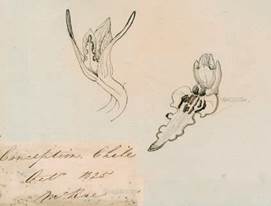
Figure 17 Drawing by Macrae of flower details of Chloraea longibracteata Lindl. on Kew Herbarium specimen #214901.
After his return to England, James Macrae was appointed in 1827 to the Botanical Garden in Ceylon, where he died in 1830. Bulbophyllum macraei Rchb.f., Callista macraei Kuntze, Cirrhopetalum macraei Lindl., and several other orchids from the Asian region were named in his honor.
German botanist Eduard Friedrich Poeppig (1798-1868) arrived in Chile in 1827, the first South American country on a five-year journey that would take him later to Peru and the Amazon. During two years of plant collecting in Chile, he discovered a large number of new orchid species, the majority of which he described in 1827 in his Fragmentum Synopseos Plantarum Phanerogamum ab Auctore Annis MDCCCXXVII ad MDCCCXXIX in Chile lectarum. In 1835, Poeppig published with the collaboration of Stephan Endlicher, his most important work, Nova General et Species Plantarum quan in Regno Chilensis Peruviano et in terra Amazonica, describing several additional Chilean orchids, and providing illustrations of many of them.
The orchids described in Poeppig's Fragmentum (1833) were the following: Asarca glandulifera (= Gavilea glandulifera (Poepp.) M.N.Correa) (Fig. 18A), A. maculosa (= Chloraea galeata Lindl.), A. parviflora (= Chloraea parviflora (Poepp.) Murgues & Novoa), Chloraea alpina, C. campestris (= C. multiflora Lindl.), C. chrysantha, C. cylindrostachya, C. decipiens (= C. lamellata Lindl.), C. fimbriata (= Bipinnula fimbriata (Phil.) I.M.Johnst.), C. grandiflora, C. incisa (= C. virescens (Willd.) Lindl.), C. lindleyi (= C. gavilu Lindl.), C. nudilabia, C. speciosa (Fig. 19), C. viridiflora, the new genus Gavilea, G. acutiflora (= Gavilea lutea (Comm. ex Pers.) M.N.Correa), G. leucantha (= Gavilea venosa (Lam.) Garay & Ormerod), and G. odoratissima. Furthermore, in Poeppig and Endlicher's Nova General et Species Plantarum we find additionally Asarca acutiflora (Fig. 18B), A. bidentata, A. leucantha, A. odoratissima, and Habenaria pumila, for a total of 23 new species. As of today, 13 of these taxa are still considered valid, according to Novoa et al. (2015).
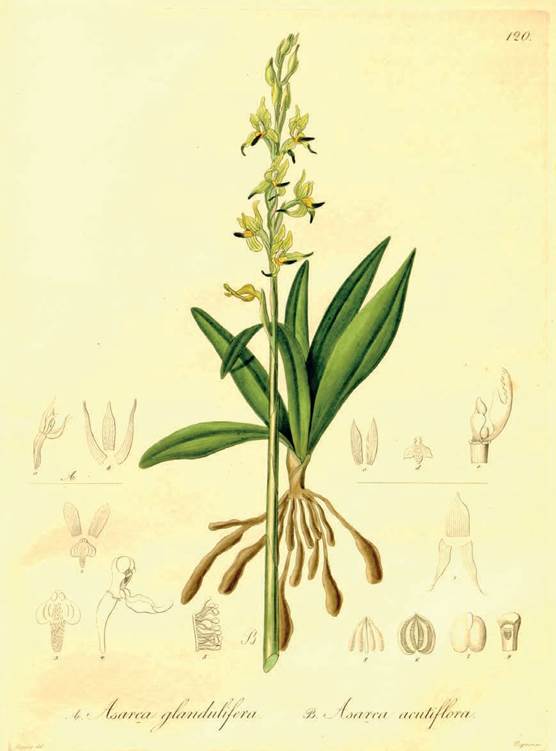
In Poeppig & Endlicher, 1835, vol. II: plate 120.
Figure 18 Asarca glandulifera Poepp. & Asarca acutiflora Poepp.
Carlo Giuseppe Luigi Bertero (1789-1831) set off for the New World and settled in Chile in 1827 after sailing on a ship where he earned his passage working as the ship's doctor. In Chile, he mostly collected in the central region. First, he botanized in the surroundings of Valparaíso and then in Viña del Mar and Quillota on his way to Santiago; from there, he traveled south to Rancagua. Bertero was in Chile until 1831 and collected an important number of botanical specimens, among them a few orchids (Fig. 20). At a certain moment, he presented to Claude Gay with a duplicate set of his specimens. These specimens, 443 in total, represent the oldest collection of Chilean plants at the Herbarium of the Natural History Museum in Santiago. Among his orchid specimens are the following, which were named in his honor: Asarca berteri Rchb.f. (= Gavilea longibracteata (Lindl.) Sparre ex L.E.Navas), Chloraea berteroana Kraenzl., and C. suaveolens Phil (= both synonyms of C. galeata Lindl.). In 1831, Bertero took a ship to Tahiti, where he collected for ten weeks. He then started on the return trip to Valparaiso, but his ship was lost at sea and never heard of again (Ossenbach 2020).
Jeremiah N. Reynolds (1799-1858) was an American newspaper editor, lecturer, and adventurer who became an influential advocate for scientific expeditions. Reynolds gained support from private sources for an expedition to the South Pole that sailed from New York City in 1829. The expedition reached Antarctica with much danger and returned north. However, in Valparaiso, the crew mutinied and set Reynolds ashore. For two years, Reynolds explored the surroundings of Valparaiso and collected several botanical specimens that became part of William Hooker's herbarium. Among them, Lindley found two new orchid species, which he described as Chloraea longipetala (Fig. 21) and C. semibarbata (= C. lamellata Lindl.). In May 1839, the New York literary magazine The Knickerbocker published Mocha Dick: Or the White Whale of the Pacific (Fig. 22), Reynolds' account of Mocha Dick, a white sperm whale off Chile, who bedeviled a generation of whalers for thirty years before succumbing to one. Reynolds' novel influenced Herman Melville's Moby Dick (1851).
On his third South American voyage, Charles Gaudichaud-Beaupré (1789-1854) landed in Valparaíso in 1831. During his brief visit to Chile, Gaudichaud collected a specimen of Chloraea gaudichaudii Brong. He had collected the holotype of this species during a previous journey on the Falkland Islands.
During his famous voyage on the Beagle, Charles Darwin (1809-1882) touched Chilean land in Elisabeth Island in 1834, at the entrance of the Strait of Magellan. He collected there a new species of orchid, which Joseph Hooker described as Chloraea magellanica (Fig. 23).
Claude Gay's explained the purpose of his Historia física y Política de Chile in the prologue to volume I (Botany), in 1845: ''In the particular works that we will publish under the title Flora and Fauna of Chile, we will describe as clearly as possible how many plants and how many animals we have been able to discover on Chilean soil; but we will also add what other authors have already said about this matter, even if we were not always able to gather the specimens that they mention. They will not be numerous, however; I have consecrated ten years in search of them; I have successively traveled in each of the ten provinces that make up the republic; and consequently, I have collected most of their products, until I am in a state of forming my catalog with such accuracy that, without fear and without presumption, I can say that no other extra-European country will offer anything similar… When, in 1830, we arrived at that Republic, three-fourths of all species of the Chilean Flora were not known to botanists'' (Gay 1845).
As we read above, the first collection of herbarium specimens of Chilean plants was the one that Bertero offered to Claude Gay shortly after Gay's arrival in Santiago. Eduard Friedrich Poeppig, on his return to Germany, brought with him 900 specimens of Chilean plants. The importance of Claude Gay's collections in Chile is evident considering that in his Historia Física y Política he described a total of 3467 species. Of these, about 1500 specimens correspond to isotypes of species new to science. Among these specimens we find several new orchid species: Chloraea rypaloglossa A.Rich. (= C. galeata Lindl.), C. homopetala Phil. (C. nudilabia Poepp.) (Fig. 24), and a few others described by Richard in Gay's Historia Física y Política.
''Early nineteenth-century resident collectors included Hugh Cuming (1819-1831), Carlo Bertero (1828-1841), and Claude Gay (1828, 1832 and 1834- 1842); Gay's contribution was by far the most considerable.'' (Frodin 2001). Gayana Botánica, the scientific journal of the Faculty of Natural Sciences and Oceanography of the University of Concepción, was created in honor of Claude Gay.
As to Orchidaceae, and with the exception of the species enumerated by Lindley in his Genera and species of orchidaceous plants (1840), Gay's work represents the first comprehensive compilation of the Chilean genera and species that were known in 1849, the year of its publication. Table 1 contains a list of Chilean orchids, as described by Gay in volume V (Gay, 1849: 435-476). Gay mentioned 49 different species in five genera, as follows: Chloraea Lindl. (32 spp.), Bipinnula Juss. (2 spp.), Asarca Poepp. (11 spp.), Codonorchis Lindl. (2 spp.), and Spiranthes L.C.Rich. (2 spp.). The author has attempted to determine the currently valid names for these species, a difficult enterprise considering the enormous synonymy which is usual among the terrestrial orchids of both hemispheres, due to -among other reasons- the historical presence of a large number of botanists in regions with a reduced variety of species. Fortunately, much work has been done in the past decades on the taxonomy of the terrestrial orchids of the southern cone. The author has, therefore, under the recommendation of reputed taxonomists, relied only on Rodríguez et al. (2018).
To twenty-one of the orchids included in Gay's work were given names that are still accepted today. Gay admits the difficulties in the classification of the Orchidaceae of Chile: ''Among the forty-nine orchids which we will describe according to our collections and those of Poeppig and Lindley, about half are poorly known and deserve special attention by the botanists of this country'' (Gay 1849).
Carl Reiche wrote in the introduction to his Orchidaceae chilenses (1910:1): ''it is a deplorable and strange fact that all the publications that deal with the vegetation of Chile, are insufficient with respect to Orchids. Already in the first general compilation that Claudio Gay made of the flora of Chile (1849) the treatment of the Orchids is one of the weakest collaborations''. A bitter but unjustifiable complaint, taking into consideration, as we read above, that only a handful of orchids were known in Chile when Claudio Gay arrived at its shores.
Table 1 Claude Gay's orchids in his Historia Física y Política de Chile.
| Name as given by C. Gay | Original collector (date) | Accepted names according to Rodríguez et al. (2018) |
|---|---|---|
| I. Chloraea Lindl. | TYPE: Feuillée (1712-1714) | |
| 1. C. affinis Lindl. | Cuming (1828-1830) | C. bletioides Lindl. |
| 2. C. alpina Poepp. | Poeppig (1829-1830) | C. alpina Poepp. |
| 3. C. aurantiaca Lindl. | Cuming (1828-1830) | C. chrysantha Poepp. |
| 4. C. barbata Lindl. | Cuming (1828-1830) | C. barbata Lindl. |
| 5. C. campestris Poepp. | Poeppig (1829-1830) | C. multiflora Lindl. |
| 6. C. chrysantha Poepp. | Poeppig (1829-1830) | C. chrysantha |
| 7. C. commersonii Brong. | Commerson (1767) | Gavilea lutea (Comm. ex Pers.) M.N.Correa |
| 8. C. crispa Lindl. | Feuillée (1712-1714) | C. cristata Lindl. |
| 9. C. cristata Lindl. | Cuming (1828-1830) | C. cristata |
| 10. C. cuneata Lindl. | Cuming (1828-1830) | C. cuneata Lindl. |
| 11. C. cylindrostachya Poepp. | Poeppig (1829-1830) | Correorchis cylindrostachya (Poepp.) Szlach. |
| 12. C. densa A.Rich. | Gay (?) | C. multiflora (Fig. 25) |
| 13. C. disoides Lindl. | Macrae (1825) | C. virescens (Willd.) Lindl. |
| 14. C. gaudichaudii Brong. | Gaudichaud-Beaupré (1828 - Falkland Islands) | C. gaudichaudii Brong. |
| 14. C. gayana A.Rich. | Gay (probably 1834) | C. speciosa Poepp. (Fig. 26) |
| 15. C. grandiflora Poepp. | Poeppig (1829-1830) | Ulantha grandiflora (Poepp.) Szlach. |
| 16. C. incisa Poepp. | Poeppig (1829-1830) | C. virescens |
| 17. C. lamellata Lindl. | Macrae (1825) | C. lamellata Lindl. |
| 18. C. longipetala Lindl. | Reynolds (1830) | C. multiflora Lindl. |
| 19. C. magellanica Hook. | Darwin (1834) | C. magellanica Hook. |
| 20. C. multiflora Lindl. | Macrae (1825) | C. multiflora |
| 21. C. nudilabia Poepp. | Poeppig (1829-1830) | C. nudilabia Poepp. |
| 22. C. odontoglossa A.Rich. | Gay (1835) | C. virescens (Fig. 27- 28) |
| 23. C. pavonii Lindl. | Pavón (1782-1783) | not mentioned by Rodríguez et al. 2018 |
| 24. C. piquichen Lindl. | Feuillée (1712-1714) | C. virescens (Willd.) Lindl. |
| 25. C. poeppigiana A.Rich. | Gay (?) | C. multiflora Lindl. |
| 26. C. rypaloglossa A.Rich. | Gay (1839) | C. galeata Lindl. (Fig. 29) |
| 27. C. semibarbata Lindl. | Reynolds (1830) | C. lamellata Lindl. |
| 28. C. speciosa Poepp. | Poeppig (1829-1830) | C. speciosa Poepp. |
| 29. C. ulanthoides Lindl. | Macrae (1825), Cuming (1828-1830) | C. bletioides |
| 30. C. virescens Lindl. | Feuillée (1712-1714) | C. virescens (Willd.) Lindl. |
| 31. C. viridiflora Poepp. | Poeppig (1829-1830) | C. viridiflora Poepp. |
| I. Bipinnula Com. ex A.Juss. | TYPE: Commerson (1767) | |
| 1. B. mystacyna Lindl. | Cuming (1828-1830) | B. fimbriata (Phil.) I.M.Johnst. |
| 2. B. plumosa Lindl. | Macrae (1825) | B. plumosa Lindl. |
| III. Asarca Lindl. | TYPE: Pavón (1782-1783) | |
| 1. A. acutiflora Poepp. | Poeppig (1829-1830) | Gavilea lutea |
| 2. A. alaris Lindl. | Macrae (1825) | C. galeata |
| 3. A. bidentata Poepp. | Poeppig (1829-1830) | C. bidentata (Poepp. & Endl.) M.N.Correa |
| 4. A. glandulifera Poepp. | Poeppig (1829-1830) | G. glandulifera (Poepp.) M.N.Correa |
| 5. A. kingii Hook.f. | Captain P. G. King (1842) | G. kingii (Hook.f.) M.N.Correa |
| 6. A. leucantha Poepp | Feuillée (1712-1714) | G. platyantha (Rchb.f.) Ormerod (Fig. 30) |
| 7. A. maculosa Poepp. | Poeppig (1829-1830) | C. galeata Lindl. |
| 8. A. odoratissima Poepp. | Poeppig (1829-1830) | G. odoratissima Poepp. |
| 9. A. parviflora Poepp. | Poeppig (1829-1830) | C. parviflora (Poepp.) Mourgues & Novoa |
| 10. A. sinuata Lindl. | Macrae (1825) | G. longibracteata (Lindl.) Sparre ex L.E.Navas |
| 11. A. verrucosa A.Rich. ex Gay | Gay (?) | G. longibracteata (Fig. 31) |
| IV. Codonorchis Lindl. 1. C. lessoni Lindl. | TYPE: Lesson (1826-1829) Lesson (1826-1829) | C. lessoni Lindl. |
| 2. C. poeppigii Lindl. | Poeppig (1829-1830) | C. lessoni |
| IV. Spiranthes L.C.Rich. 1. S. chilensis A.Rich. | TYPE: Probably L.C.Rich. Gay (?) | Brachystele unilateralis (Poir.) Schltr. |
| 2. S. diuretica Lindl. | Feuillée (1712-1714) | B. unilateralis (Poir.) Schltr. |
Note: The author has, under the recommendation of reputed taxonomists, relied only on the account on the Chilean orchids that Novoa prepared for the recent catalog of vascular plants of Chile by Rodríguez et al. (2018).
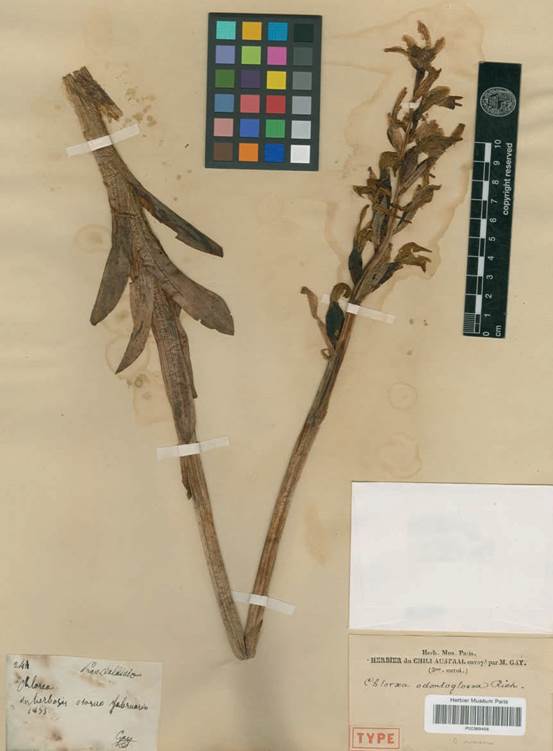
Figure 28 Chloraea odontoglossa A.Rich. Herbarium specimen, National Museum of Natural History, Paris.
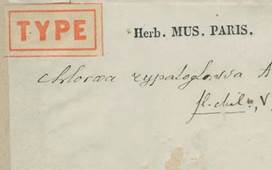
Figure 29 Gay's herbarium label of Chloraea rypaloglossa A.Rich. Herbarium, National Museum of Natural History, Paris.
The collaborators of Gay's Historia física y política de Chile
After receiving honorary Chilean citizenship, Claude Gay returned to France in 1842 and took with him the greater part of his botanical collections in order to fulfill his commitment to the Chilean government. A total of 1923 of his specimens are held today at the Natural History Museum in Paris. In the preparation of his magnum opus, he was assisted by a number of renowned French botanists. Thus Jean Pierre François Camille Montagne (1784-1866) wrote the treatment of the Cryptogams; François Marius Barnéoud (1821-?) of the Brassicaceae, Sapindaceae, Geraniaceae, Vivianaceae, Tropeolaceae, Oxalidaceae, Myrtaceae, and Portulacaceae; Dominique Clos (1821-1908) of Fabaceae, Rosaceae, Umbelliferae, Rubiaceae, Valerianaceae, Boraginaceae, Lamiaceae, and Scrophulariaceae; Joseph Descaine (1807-1882) of the Plantaginaceae; Étienne-Émile Desvaux, (1830-1854) was in charge of Cyperaceae and Poaceae; Charles Victor Naudin (1815-1899) of the Caryophyllaceae and Elatinaceae; Jules Ezechiel Rémy (1826-1893) wrote the treatments of the Saxifragaceae, Polygonaceae, Calyceraceae, Compositae, Phytolacaceae, Verbenaceae, and Solanaceae. Last but not least, the most important figure in our field of study was Achille Richard (1794-1852) (Fig. 32), responsible for the Orchidaceae. The remaining families, a total of 103, were prepared and written by Claude Gay himself (Muñoz Schick 2010).
Richard played an important role during the first years of Gay's education in Paris and twenty-five years later in the publication of Gay's Historia física y política. Richard and Adrien-Henri de Jussieu (1797-1853) would be Gay's first mentors and his counselors until their last days.
The members of the French Richard family dedicated themselves over several generations to Natural History, particularly to botany. Claude Richard (1705-1784) was in charge of the Botanical Garden of the Palace of Trianon under the direction of Bernard de Jussieu (1699-1777). In order to enrich the garden, he corresponded with all the important botanists of his time, such as Carl Linnaeus, Albrecht von Haller (1708-1777) and Nikolaus Joseph von Jacquin. Claude's eldest son, also Claude Richard, directed the garden that Louis XV acquired in 1761 in the village of Auteuil, and was succeeded in this position by his brother, Antoine Richard (1734-1807). With good reason would Georges Cuvier (1769-1832) say of Claude Richard's grandson, Louis-Claude Marie Richard (1754-1821), that he had sucked botany with the milk; there was not one moment in his life in which he was not a botanist; and if he dedicated himself to other studies, it was only and always in relation to botany (Cuvier 1825, Ossenbach 2020). The last of the dynasty, Achille Richard, son of Louis-Claude Marie Richard, was responsible for introducing Claude Gay into the circles of the Natural History Museum in Paris, and there is no doubt that the Historia Física y Política de Chile could not have been written without free access to the Museum's Library and Herbarium.
Despite difficulties in financing his work, Gay published in 1844 the first fascicle of his Historia Física y Política de Chile. The publication of the following fascicles suffered due to the lack of resources and Gay's problems in his marriage. However, all obstacles were surmounted, and the last volume was completed in 1871.
Claude Gay returned to Chile in 1863, at the age of 60. ''Before I die, he wrote to his friend Barros Arana, I wished to see once again this beautiful country and the excellent friends that I have here''. President Manuel Bulnes received him with honors and the Chilean Congress awarded him a lifelong annual pension of 2000 Chilean pesos. After his return to France, he lived through the convulsions of the Commune de Paris and the Franco-Prussian war and died in Paris in 1873 (Anonymous 2016).
In his contract as professor of Physics, Chemistry, and Natural History of Chile, Claude Gay saw, beyond the start of a career devoted to teaching, ''the certain possibility of taking up research in a land almost unknown to European scientists'' (Gay 2008). His vision became reality. When Gay arrived in Chile in 1828, the known vascular plants of this country numbered around 300. In his Historia Física y Política, he described a total of 3767 vascular plants, a number which had only increased to 4340 in 2010 (Muñoz Schick 2010). In a remarkable tour de force, Claudio Gay had brought the flora of Chile into the European universe. Since he arrived for the first time in Chile in 1828, he had dedicated his entire life to the sole purpose of making Chile known to both Chileans and the French.












 uBio
uBio 
